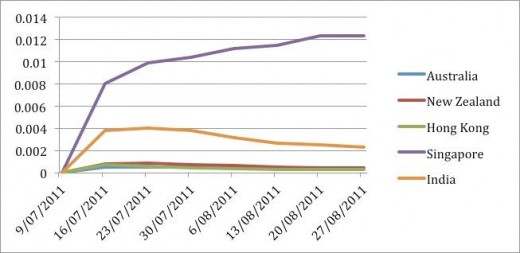
Singapore is the most active user of Google+ in Asia, according to the latest figures by Experian Hitwise.
But the data, which is based on Google+’s share of visits from Asia-Pacific (APAC) countries over 8 weeks (ending on 27 August 2011), contradicts other reports which had claimed that the APAC region was responsible for a large percentage of users on the social networking service.
Singapore leads the way on Google+ in APAC
It seems strange to think that a city-state with a population of less than 4.5 million can reign over a continent that is approaching 4 billion inhabitants, but it seems that that is indeed the case, at least with Google+.
Singapore is well known as a harbinger of the western world in Asia. Its level of technology and services adoption is beyond that of many of its neighbours. Singaporeans — including the large percentage of foreigners living there — are comparatively advanced Internet users and technology lovers.
For example, as CNET explains, Singapore has the highest number of iOS devices per person anywhere in the world.
It also consistently finds itself at the top of the world’s social media landscape, with usage rates much higher than its relatively diminutive population would have your believe. It is one of the top 15 Facebook users in the whole Asia-Pacific (APAC) region, according to SocialBakers, and Sysomos found that it was among the world’s top 20 markets for Twitter. Given all this, it’s not strange to see the country’s residents leading the way in Google+ usage too.

Is Google+ struggling in Asia?
Given the country’s relatively low population (compared to countries like China and India), however, the fact that Singapore is out in front on Google+ usage suggests that the service has struggled to find attention in other markets, particularly those where English is not a first language.
Hitwise Experian looks specifically at Hong Kong, which might be expected to be a bigger user of the service, noting that its “lower rate of adoption could be attributed to the more established presence and use of local Chinese sites in the social networking category”.
The firm goes on to explain that although around 60% of Hong Kong-based Internet users visit English-language sites like Facebook, 40% of the country’s Internet visits are to Chinese-language sites, including forums and social media sites such as Discuss, Uwants and microblogging giant Sina Weibo.
What about India…the world’s largest democracy?
Since Google+ was launched, India has been much talked of as a potentially huge market for it. However, the research suggests that such talk may be premature, even though India was the world’s 14th most active on Google+ when usage was at its peak.
Given its gigantic population and penchant for using social networking services, we would have expected India’s usage of Google Plus to be considerably higher, but it could well be that, despite a promising launch, Indians are reducing their usage of the service now. Given that both Facebook and Orkut command substantial numbers of users in the country already, perhaps there is no space—or limited enthusiasm—for a third competing social networking service.
Traffic vs. active users
Hitwise primarily monitors traffic, but the bulk of reporting has been done via user numbers, which is arguably less clear of a metric than traffic.
Without further information about the process used to gather data, it is impossible to be more specific on which data is correct. However, with a large number of Google+ users noted as being inactive, Asia could well have many registered users who do not contribute to the site’s traffic.
Looking at the numbers overall, Asia is currently a small market for Google+, much in the same way that it initially was for Facebook, Twitter and a host of other social networking websites. However, perhaps the research methodology plays a larger hand in this conclusion than is evident, given that there have been many reports in the past of the service’s success in Asia—and particularly in India.
The big question is whether the service will still be around, and popular enough, to have made an impact on Asia in a year or two. Or will it be another has-been by then? Only time will tell.
Get the TNW newsletter
Get the most important tech news in your inbox each week.





